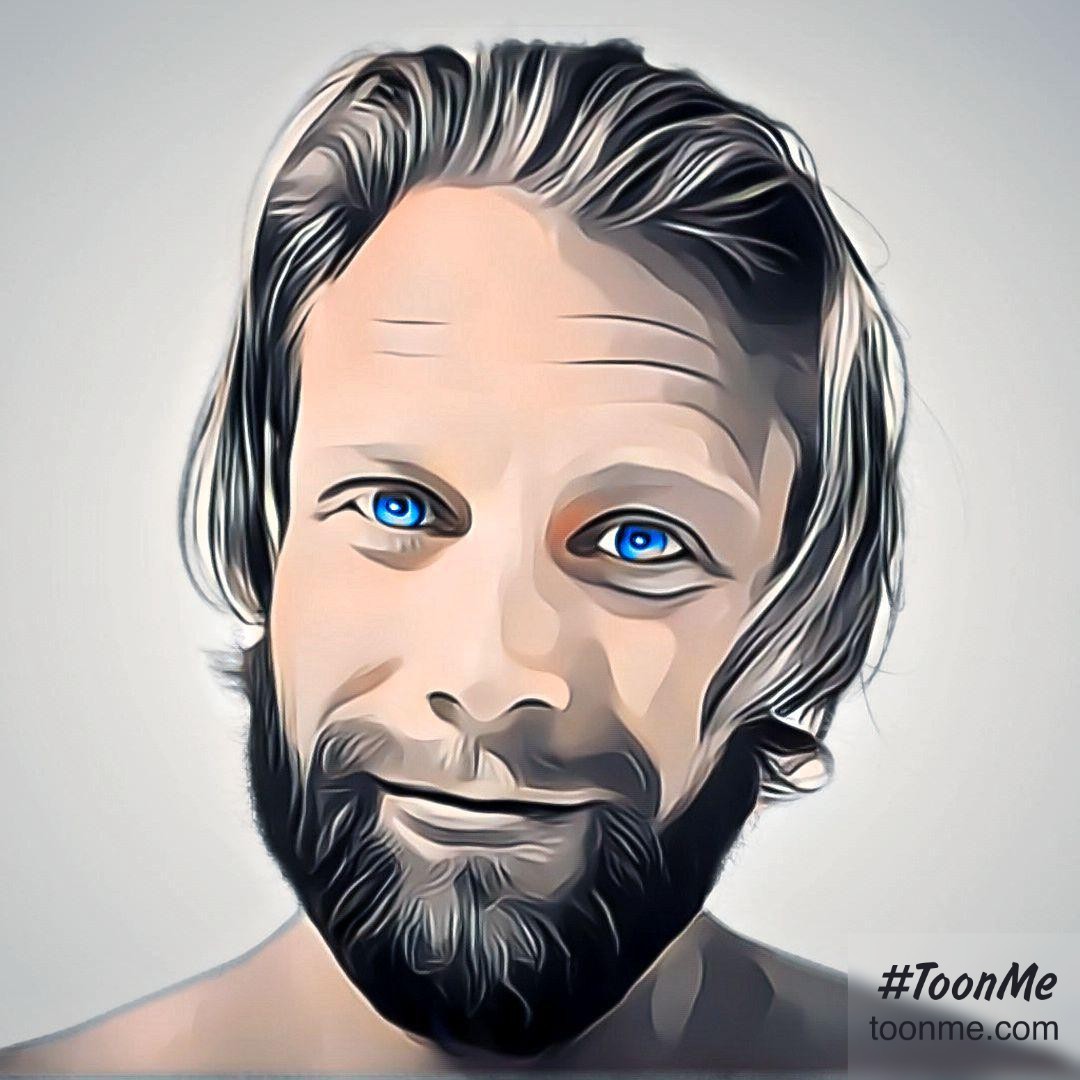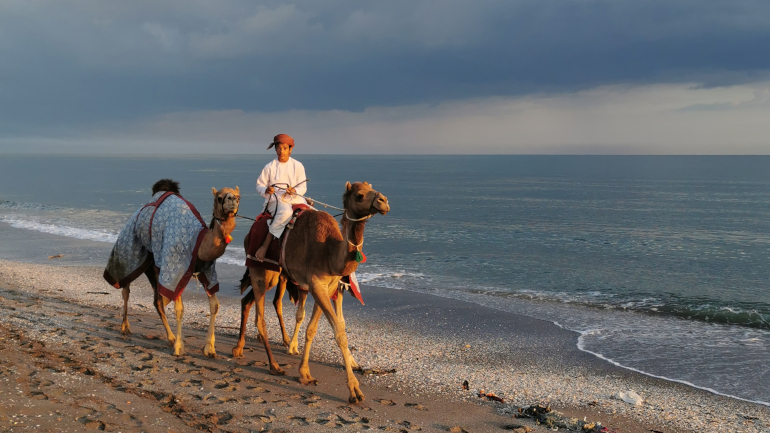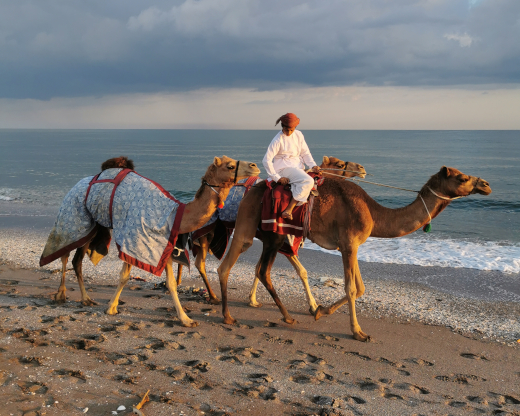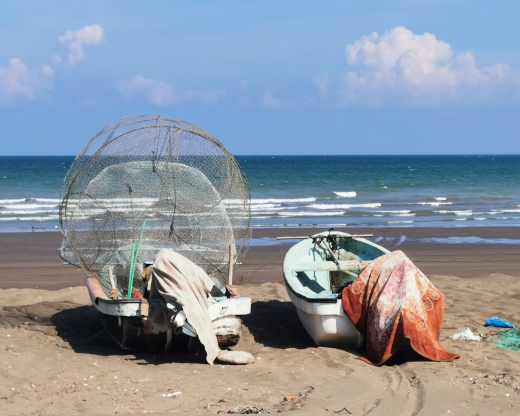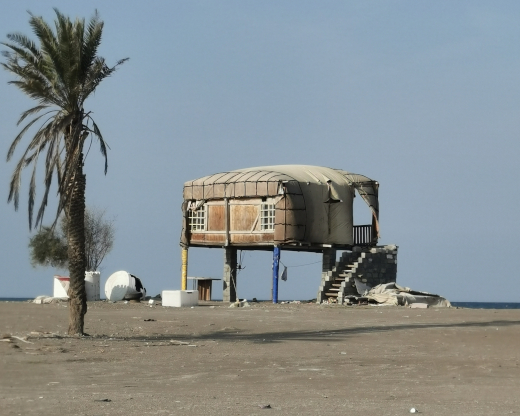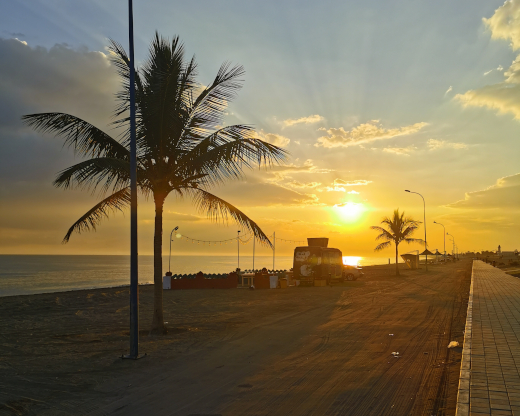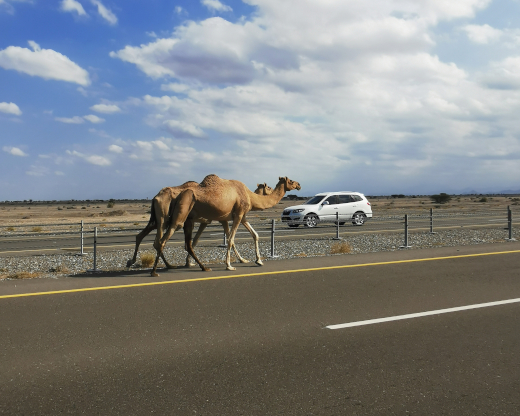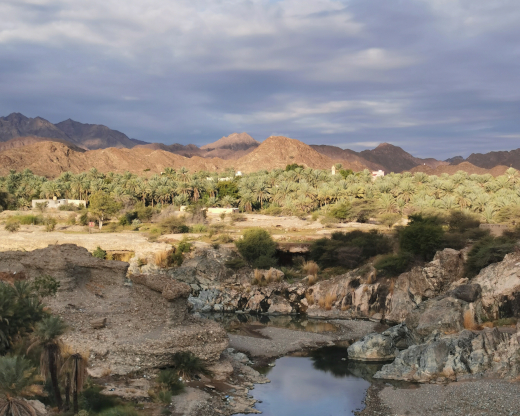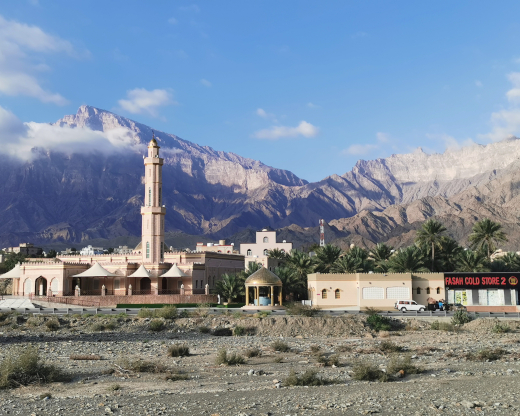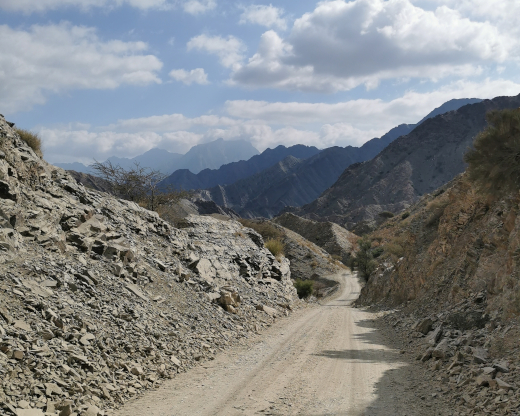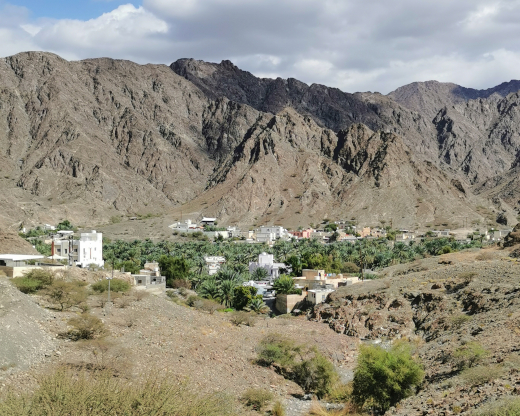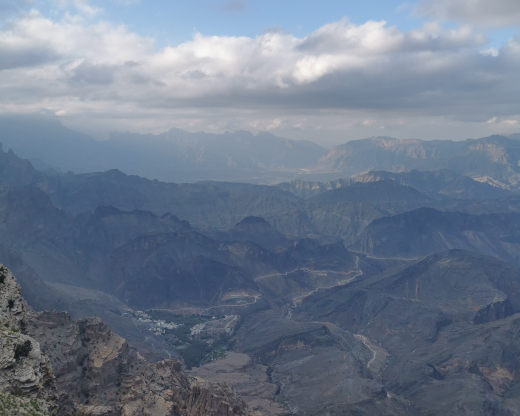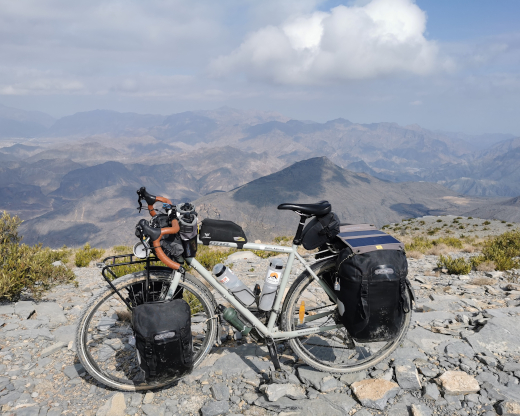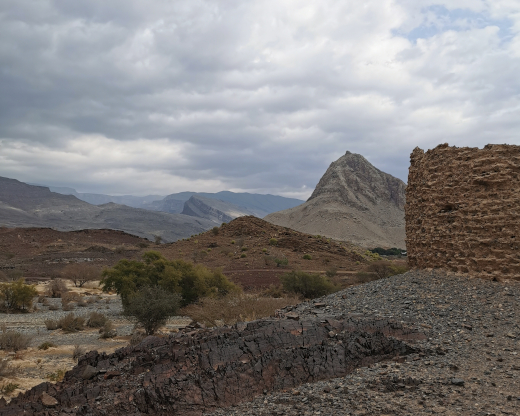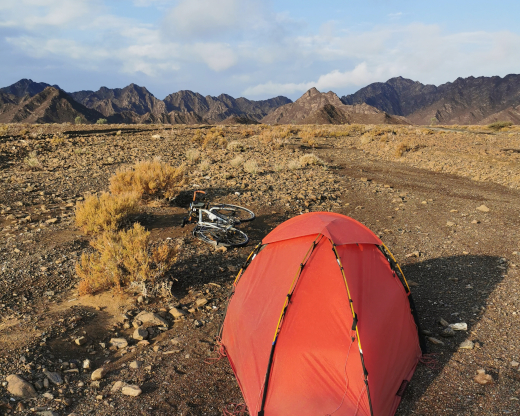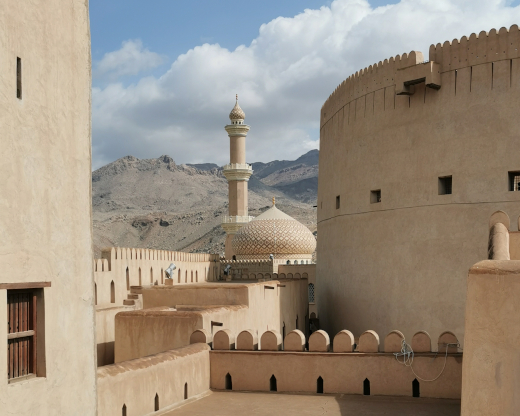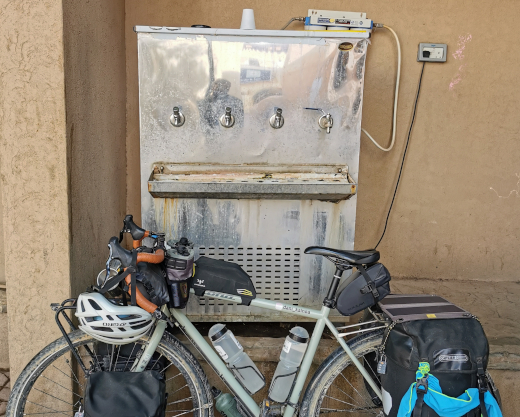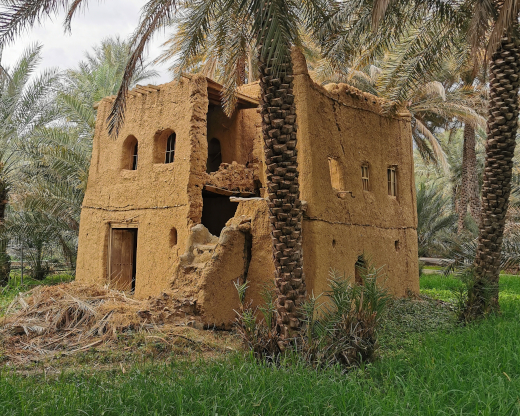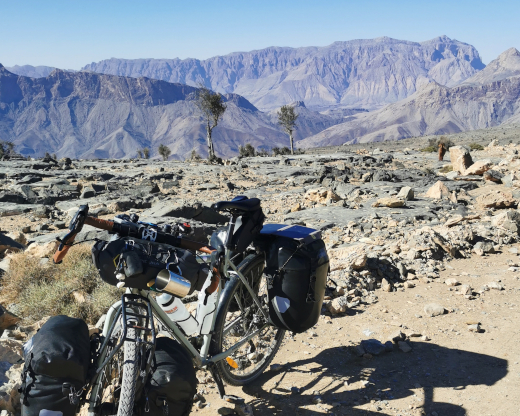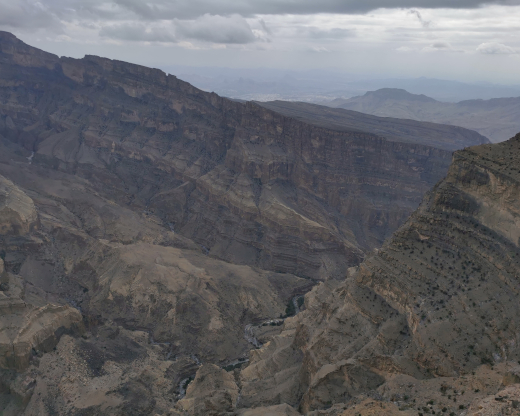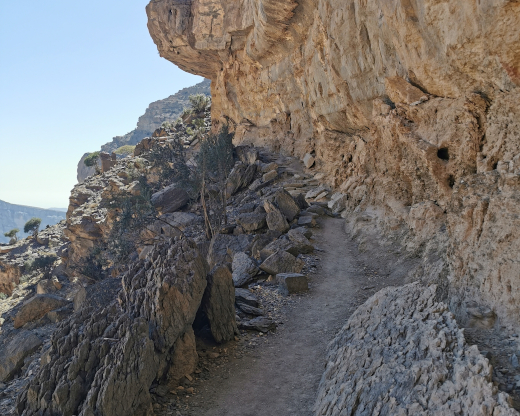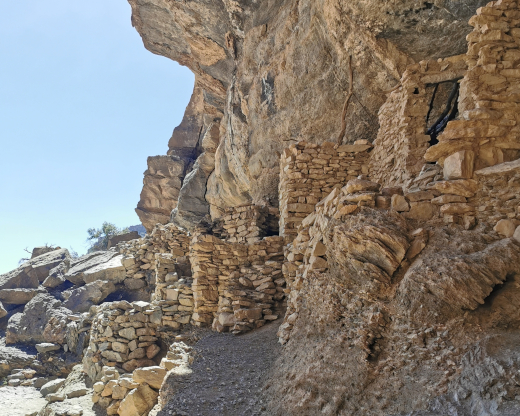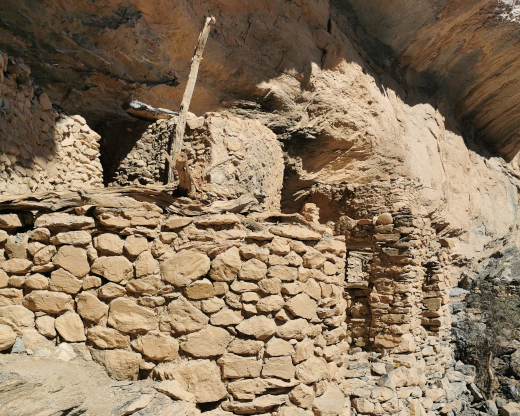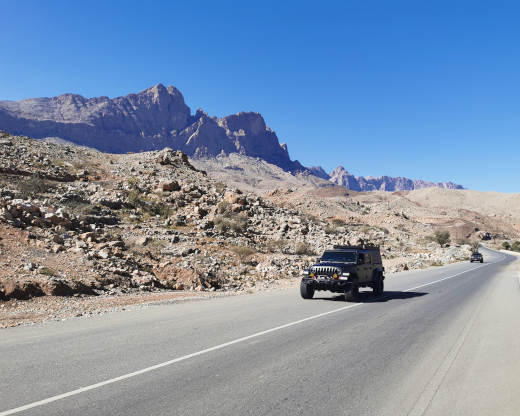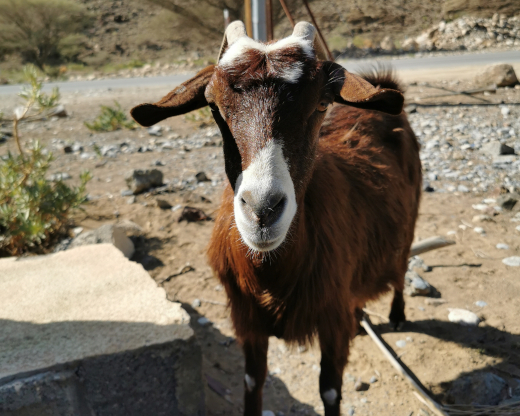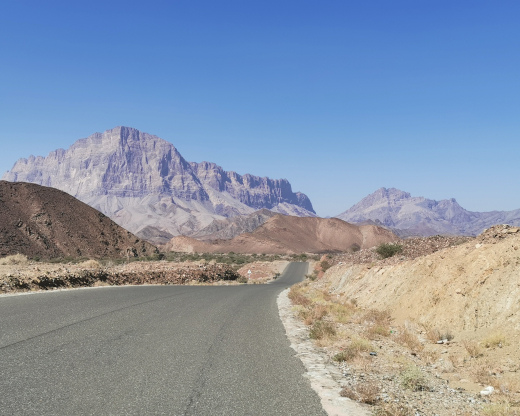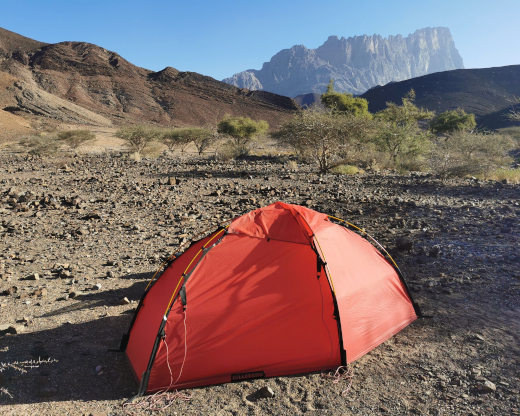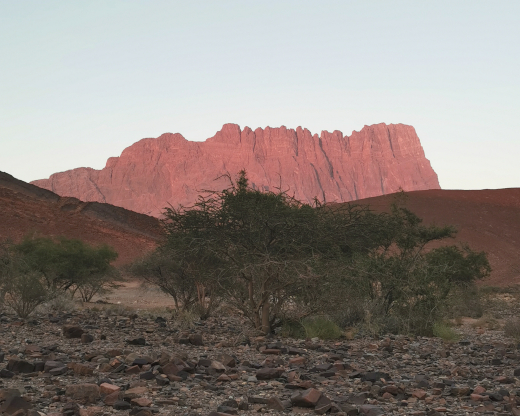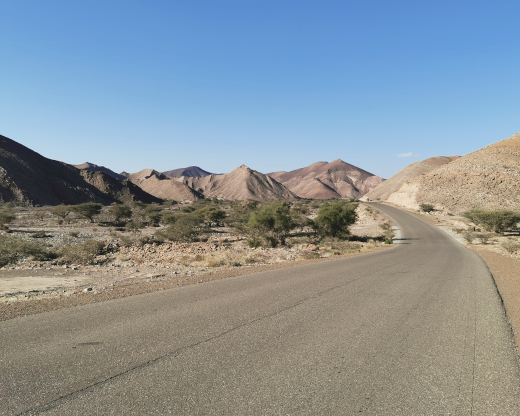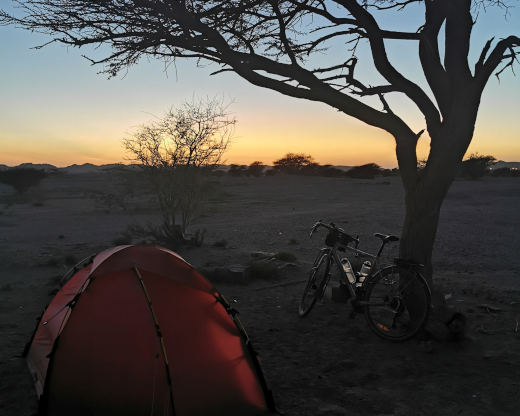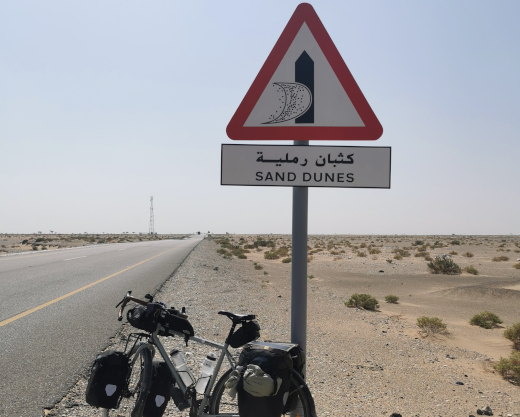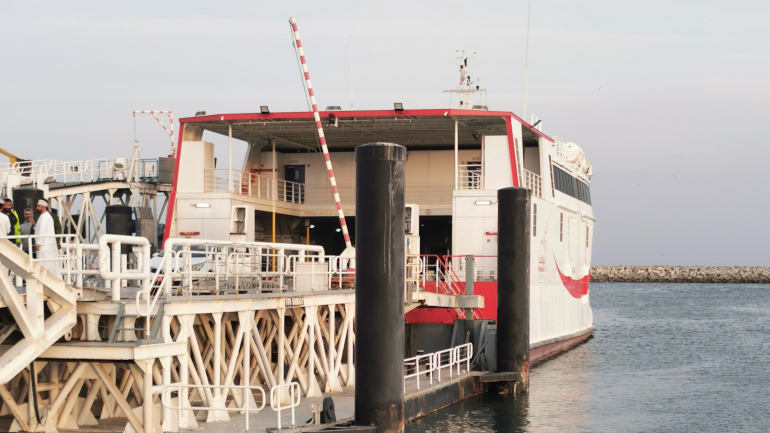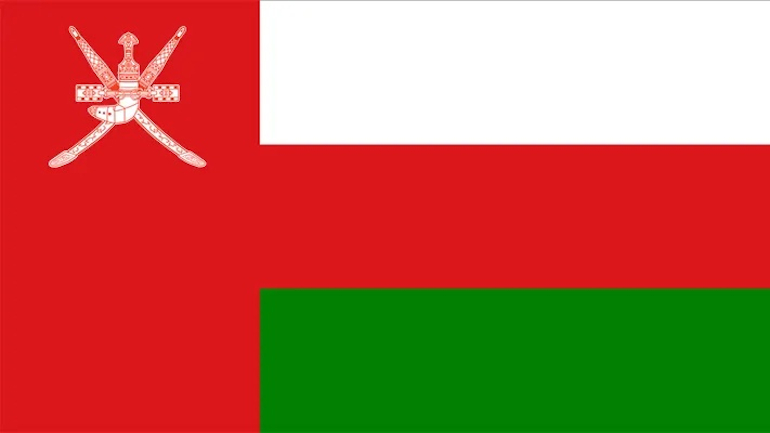Contents [hide]
Intro
Friendly locals in traditional clothing waving and offering help, seemingly endless coastal roads, wadis with palm tree oases. Steep mountains and the Arabic Grand Canyon, stubborn camels and sneaky goats everywhere. Welcome to the northern mainland of Oman.
Recap of week 83 to 85
After waiting four additional days on the Musandam peninsula due to a canceled ferry departure, I was happy to plant both my bike wheels on the mainland of Oman. I biked along coastal roads from Shinas to As Suwaiq and watched fishermen drag their nets onto shore. Boats were seeking shade under palm leaf thatched beach huts and the smell of dead fish left to dry under the beating sun was all around me.
I headed inland towards the Hajar Mountains through Wadi Hawqayn and marveled at the palm tree oases that defied the ruthless sun and heat. I fought a losing battle against slippery gravel on my way up to Birkat Al Sharaf Mountain. Up for some easy road days, I biked past Nizwa and visited their grand fort and then took some rest days in Al Hamra.
Regaining some of my honor, I did a solid effort with a lot of hike-a-bike up to a viewpoint overlooking Jebel Shams where I did the “Balcony Walk” to an abandoned village located where I never would have imagined people ever to settle.
My time was running out for Oman so I took a mountain pass shortcut to Sint and stocked up on provisions in Ibri for my upcoming crossing of the Empty Quarter in Saudi Arabia.
Coastal road biking from Sohar to Al Khaburah
Finally I was on my way again. The ferry from Khasab to Shinas left four days after scheduled departure. It was not the spectacular ferry ride I had imagined when I heard talks about the fjord landscapes of the Musandam peninsula. The coastline scenery only lasted for a short while and then we were far out to sea with little else to watch at than the ocean and a bunch of container ships. Once the ferry docked in Shinas, I hurried away and was eager to do some mileage but as I was biking out of the ferry terminal, the sun was setting behind palm trees and casting a golden glow on the minarets where muezzins were calling to prayer. My coastal ride to mainland Oman would have to wait until the next day.
Beaches here are plentiful and I stood for a short while at the roadside thinking where would be a good place to camp. A local Omani approached me and asked “How are you? Do you need any help?”. I would hear this phrase perhaps a hundred times a day during my time in Oman. No kidding. They actually really want to help - they are not just trying to be polite. This evening I was wondering where to camp and he told me about a city park just around the corner and took me to the mosque to show me where I could use a toilet. Being forthcoming and helpful in that way really makes me feel welcome. So let me just take the opportunity here to express my heartfelt thanks to all the Omanis I met on my way.
Next morning I was off to do some coastal roads. Most parts of the road are just next to the beach which gives you plenty of opportunities to watch the ocean and the coastal community that lives here. On one side you have gatherings of houses every now and then and on the other side you have the beach with small makeshift shade structures which basically is a roof thatched with palm tree leaves. These provide some vital protection from the force of the sun which gets scorching hot during summer time. Small and modest mosques are sometimes built straight on the beach, others are placed in shades of palm trees and others are hidden in between the residential houses. Common for all of them is that they occur very frequently. You don’t get to bike very far before you see your next mosque. When they call for prayer it is like hearing an echo and you see men of all ages tip-toeing across the street and further down the sandy beach to perform one of many daily prayers.
Fishermen haul their nets to shore using derelict 4wd cars or old tractors. Anchors and lobster traps take up space on the sandy stretches instead of sun beach umbrellas and inflatable toy animals. This is so far from a resort town beach as you can get. Fish are left to dry in the sun and the strong smell that fills the air reminds you how many people here sustain their living.
I spent my nights here on the beach listening at night to the sound of the ocean and watching the fluorescent green algae putting on a color show in the breaking waves. In the morning I spotted camels on a brisk morning run but besides this I had it all to myself. Just don’t camp too close to any parks or food trucks along the beach. They are a magnet to locals which come here at night. It is very lively and amazing in many ways - except if you want to go to bed early at night in your tent.
My first wadi and date palm tree oasis
Oman has over 3000 km of coastline. It’s a really long biketour if you are up for it. I settled for a shorter version. With a week of my 30 days visa already spent on the Musandam peninsula, I gave up on Muscat and Masirah Island to head inland towards and over the mountains.
I left the coast at As Suwaiq and headed up the Wadi Hawqayn. A wadi is a valley or channel that is dry except in the rainy season. Oman also has many of these due to their mountain range some 50-100 km inland from the northern coast.
The landscape instantly changed. No more smell of dead fish. Instead a vast plateau with wandering camels appeared before I entered the wadi. Some camels really like to walk along the road and eat the few grass stubs they can find - I passed two on my way. A dedicated car did what it could to honk them off the road but this camel couple didn’t seem to care. They slowly walked away stubbornly insisting to stop to eat before continuing onwards to the next grass stub. I didn’t see the end of the effort so I don’t know if it was successful or not. I really love seeing camels in the wild - they might just be the first one I ever saw outside of a zoo or chained up doing rides for tourists. But I do understand that it is dangerous for both camels and cars to be on the road so I hope the camels will listen at some point and find other feeding spots.
Happy to have encountered some wild but stubborn camels, I entered the canyon of Wadi Hawqayn. The rain comes in summer time so while I was in Oman I saw mostly dry wadis. Someplaces just a small trickle of water was running on the very bottom but it was clear that water levels here can rise rapidly. Regardless of the lack of water during winter, small oases would defiantly persist in this dry landscape. The village of Hawqayn is such an oasis. It is amazing to see how this patch of green survives amongst such a barren mountain landscape. During sunrise and sunsets the village is particularly picturesque with the mountains as a backdrop.
The date palm trees cover the oases and in between you can spot some houses. Dates are a vital source of energy and nutrition. Ingenious Omanis have found use of most parts of this tree from timber to furniture and baskets, from rope to fuel and packing material.
I spent a night camping next to the wadi which I would recommend anyone to put on their bucket list. Doesn’t need to be this particular wadi. Just go wadi exploring and find your favorite one.
Mountain galore and steep gravel madness
I actually picked Wadi Hawqayn for a reason which was to connect with some other well known wadis nestled deep in the Hajar Mountains. Wadi Sahtan and Wadi Bani Awf are the main ones. I knew beforehand that biking here would be challenging. All gravel roads with some of them being very steep. However, I figured the charming mountain villages would be all worth it. I was just not prepared on just how steep they would be (and neither did my navigation app for that matter).
It only took me a day from Wadi Hawqayn to reach what I now have dubbed as the gravel madness of Oman. I was all fired up and prepared to tackle a challenge as I started to bike into the mountains. It all went very well the first couple of hours. Then the climbing began. I remember that I looked up at the first steep climb to Bimah and said to myself that the gradient from my navigation app was way off. It should have been a 14% slope but it looked more like +25%. I began pushing the bike but as I was taking four steps up I was sliding down one step on the loose gravel. This was no good. I took off all my panniers and carried up the first set of panniers, then the second set of panniers and then the bike. Soon, I realized that I would never get over the mountain this way. Exhausted and devastated, I entered Bimah. My pride was also hurt. I never did give up on a mountain before and now I was coming to the conclusion that I would not succeed getting to this top without wearing myself down completely not to speak of the very likely chance that I would need to keep going into the night because of lack of places to pitch my tent on the narrow mountain roads.
A friendly local saw my despair and invited me for lunch. I left all my pride outside of the guest room and asked if he knew anybody that could drive me to the top. Rain would come in a couple of days and these mountain roads should not on any circumstances be navigated during rain. They turn into deadly and treacherous muddy slopes. So I had to strike a deal fast and once lunch was over, he agreed to drive me himself. We strapped my bike to the back of his pickup making sure that my bike was resting on its wheels. Laying the bike down flat on these bumpy roads would have been the end of it.
It took an hour to do the 12 km from Bimah to the top and it was a spectacular road climbing up and up and up. Very steep at times. I don’t think I ever saw so many crazy steep climbs in such a short distance. I’m happy I took the ride up even though I had given up on visiting Snake Canyon and the mounting village Bilad Sayt. Now I have something to come back for and I certainly want to give these wadis another shot but with a much lighter setup only carrying essential need-to-have gear.
I decided to camp at the top that night and soak in as much of this mountain galore nature as I could. Next day was going to be a long and fast downhill on asphalt roads all the way to Nizwa.
Nizwa and the forts of Oman
Oman is bountiful on forts and you can make it a travel theme to visit as many as you can. There are supposed to be a thousand forts spread around the sultanate so you would probably need to focus on a limited selection. Nizwa has the most visited fort but perhaps not set in the most picturesque settings. It is impressive however with a massive round tower as a center point. If you get to visit this place, make sure to educate yourself on the numerous ways they used to defend the fort. Date syrup might sound sweet but if you heat it up to boiling temperature and pour it over your intruders, it must be a gruesome deterrent. Just imagine a burning hot and sticky mass you can’t get off your skin. No wonder this fort has never successfully been invaded. The fort is also equipped with two secrete escape tunnels over 10 km long providing an excellent opportunity to survive any long lasting siege.
Nizwa is one of the oldest cities in Oman. Once a center for trade, religion and art this place is vibrant with history. Nowadays what you see is a city placed within a large plantation of date palms. It has a souq where you can take a stroll and a chaotic goat market which is an experience. For me, the best part of Nizwa was to stand on top of the fort tower and watch over what is left of the crumbling mud brick houses of the old town with date palms on all sides and in every nook and corner of the city.
From Nizwa I took a detour via Bahla to get a glimpse of their fort from the outside. I was already satisfied with my Nizwa fort so I didn’t feel the urge to visit this one as well.
Rain showers occur here and the weather is much different than from the coast. After Nizwa I didn’t see the top of the mountain range ahead of me for many days. Since I came here for the mountain views, I figured it was a good time to take some rest in Al Hamra.
Al Hamra is not really an exciting city. It is just a strip of small eateries and a few grocery stores. It does have a ruined old town where I stayed in one of the restored houses. From the rooftop terrace I sat and drank Karak tea and looked at rain dripping down on the palm leaves on the small plantation in front of me. Al Hamra mainly serves as a good base for exploring the surrounding area.
Once the rain and cloud had decided to leave the area, I biked up to Misfat al Abriyeen, a small, easily accessible mountain village. Super charming but also touristy. As many other mountain villages, there are date palms grown in terraces along the mountain side. A falaj system brings water from wadis and other water sources higher up in the mountains down to the date palm terraces through small canals and forms up a clever irrigation system. Walking along these terraces really got me back in time where I got a deeper understanding of just how important and vital this fruit tree has been as a stable food source.
Hike-a-bike and the road up towards Jebel Shams
I was not quite done with the mountains of Oman yet. Jebel Shams is a famous one in the area. Other travelers called it the Omani Grand Canyon. It’s a one way street meaning that you bike down the same way as you go up. My pride and honor was a bit hurt after I gave up on my last mountain. So I decided to go all in and bike up there with my fully loaded bike. Normally I would have left some panniers behind to go light but not this time.
Most of the road leading up to the viewpoint below the top of Jebel Shams is paved with asphalt. No more gravel madness. This being Oman, you still have some steep slopes. I made it almost all the way up on my first day with a lot of hike-a-bike pushing up the switchbacks. It became a lot colder very fast and locals asked if I was absolutely sure I would sleep up here. I explained my sleeping bag was made for extreme winter and I was not sure they understood that their winter in the mountains wouldn’t qualify as a winter at all in terms of my sleeping bag grading system. Regardless, I don’t think I convinced them as they brought a bunch of firewood to keep me warm. It turned into a really cozy night sitting by the fire and watching the stars.
Next day I made it all the way to Al Khitaym before midday and I parked my bike to get ready for a walk along the steep cliffside - they call it the Balcony Walk. From a distance you would not think there ever could be a walkable path but once you’re on it, it's actually quite mellow. Only on a few occasions do you really need to watch your step so you don’t risk falling into the Omani Grand Canyon. At the turning point and end of the Balcony Walk there are old abandoned ruins of an old village proving that people have the ability to settle on the most incredible places. They must have lived very isolated here. There’s a natural pool further up the cliff side which explains why they might have settled here in the first place.
The day was ending as I returned to my bike. Inspired by the cliffside dwellers I went on search for a camp spot for the night at the edge of the canyon cliff and found my perfect spot to sit and watch my last sunset before I would descend to the desert plateau below to do the last mileage in Oman.
Getting closer to the sand dunes of the Empty Quarter in Saudi Arabia
On my last days in Oman I biked towards Ibri. The mountains slowly vanished behind me. Jabal Misht marked the end of the peaks and high mountains turned into low hills. The landscape opened and flattened out. Only a few unremarkable towns were ahead of me and I did not linger around much in any of them. I was mentally starting to prepare for the Empty Quarter in Saudi Arabia. A big sand dune desert with only a couple of options to resupply water. I will face my longest unsupported stretches so far. I made a pit-stop in Ibri and went to Lulu Hypermarket to get food for a full week before biking towards my desert challenge.
planning and travel toolkit oman
2023-02-06 | toolkit
A practical biketouring guide and info on visa, border crossings, SIM card, budget, ATM, wild camping, dresscode, when to travel and more
